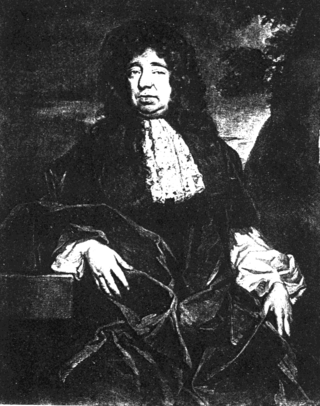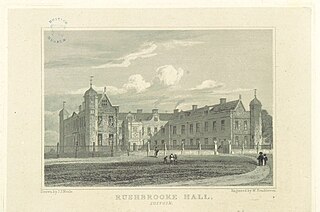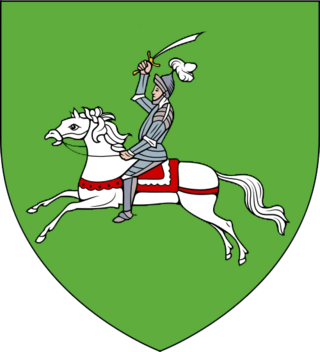Related Research Articles

Marquess of Donegall is a title in the Peerage of Ireland held by the head of the Chichester family, originally from Devon, England. Sir John Chichester sat as a Member of Parliament and was High Sheriff of Devon in 1557. One of his sons, Sir Arthur Chichester, was Lord Deputy of Ireland from 1605 to 1616. In 1613, he was raised to the Peerage of Ireland as Baron Chichester, of Belfast in County Antrim. He died childless in 1625 when the barony became extinct.

Earl of Macclesfield is a title that has been created twice. The first creation came in the Peerage of England in 1679 in favour of the soldier and politician Charles Gerard, 1st Baron Gerard. He had already been created Baron Gerard, of Brandon in the County of Suffolk, in 1645, and was made Viscount Brandon, of Brandon in the County of Suffolk, at the same time as he was given the earldom. These titles are also in the Peerage of England. Lord Macclesfield was the great-grandson of the distinguished judge Sir Gilbert Gerard, Master of the Rolls from 1581 to 1594. He was succeeded by his eldest son, the second Earl. He was involved in the Rye House Plot of 1683, was sentenced to death but later pardoned by the King. On his death without legitimate issue in 1701 the titles passed to his younger brother, the third Earl. He had earlier represented Yarmouth, Lancaster and Lancashire in the House of Commons. When he died in 1702 the titles became extinct.

Earl of Enniskillen is a title in the Peerage of Ireland. It was created in 1789 for William Cole, 1st Viscount Enniskillen. He had already been created Viscount Enniskillen in the Peerage of Ireland in 1776 and had inherited the title Baron Mountflorence, of Florence Court in the County of Fermanagh, which had been created in the Peerage of Ireland in 1760 for his father John Cole, who had earlier represented Enniskillen in the Irish House of Commons. The family are descended from the Ulster planter, Sir William Cole.

Earl of Shelburne is a title that has been created two times while the title of Baron Shelburne has been created three times. The Shelburne title was created for the first time in the Peerage of Ireland in 1688 when Elizabeth, Lady Petty, was made Baroness Shelburne. She was the wife of the noted economist Sir William Petty. The title was for life only and became extinct on her death in circa 1708. On the same day that Lady Shelburne was elevated to the peerage, her eldest son by Sir William Petty, Charles Petty, was also raised to the Peerage of Ireland as Baron Shelburne. He died young in 1696, when the title became extinct. The barony was created for a third time in the Peerage of Ireland in 1699 in favour of the Hon. Henry Petty, younger son of Sir William Petty and Lady Shelburne. In 1719 he was further honoured when he was made Viscount Dunkerron and Earl of Shelburne, also in the Peerage of Ireland. On his death in 1751 these titles also became extinct.

Earl of Strafford is a title that has been created three times in English and British history.

Baron Bellew, of Barmeath in the County of Louth, is a title in the Peerage of Ireland. It was created on 17 July 1848 for Sir Patrick Bellew, 7th Baronet, who had previously represented Louth in the House of Commons as a Whig and also served as Lord Lieutenant of County Louth. His grandson, the third Baron, was also Lord Lieutenant of County Louth and sat in the House of Lords as an Irish Representative Peer from 1904 to 1911. He was succeeded by his younger brother, the fourth Baron. He was an Irish Representative Peer from 1914 to 1931. In 1881 Lord Bellew assumed by Royal licence the additional surname of Bryan under the terms of the will of his maternal uncle Colonel George Bryan. However, he is the only one of the Barons to have held this surname. On his death the titles passed to his nephew, the fifth Baron, and then to his younger brother, the sixth Baron. As of 2018 the titles are held by the latter's grandson, the eighth Baron, who succeeded in 2010.

Baron Athenry is one of the oldest titles in the Peerage of Ireland, but the date of its creation is thoroughly uncertain; each of the first four Berminghams listed below is claimed by some writers to have been Lord Athenry, but the evidence is disputed. The title appears to have been given to the de Birmingham family of Birmingham, Warks, England as a reward for their help in the Norman invasion of Ireland in 1172. Both Sir William de Birmingham, and his son Robert de Birmingham, are variously claimed to have been involved in the invasion, but it is probable that, after the invasion, William returned to his home in England and left Robert their new lands in Ireland.

The Jacobite peerage includes those peerages created by James II and VII, and the subsequent Jacobite pretenders, after James's deposition from the thrones of England, Scotland and Ireland following the Glorious Revolution of 1688. These creations were not recognised in English, Scots or Irish law, but the titles were used in Jacobite circles in Continental Europe and recognised by France, Spain and the Papacy.
The titles of Viscount of Melfort and Lord Drummond of Gillestoun were created in the Peerage of Scotland on 14 April 1685 for John Drummond, second son of James Drummond, 3rd Earl of Perth, with remainder to the heirs male of his body by his second marriage, to Euphemia Wallace, failing whom to the heirs male of his body whatsoever. He was further created, on 12 August 1686, Earl of Melfort, Viscount of Forth and Lord Drummond of Riccartoun, Castlemains and Gilstoun, also in the peerage of Scotland, and with a similar remainder.
A list of the Lord Lieutenants of Fermanagh, located County Fermanagh of Northern Ireland, U.K.

Baron North, of Kirtling Tower in the County of Cambridge, is an abeyant title in the Peerage of England. Its most famous holder was Frederick North, 2nd Earl of Guilford, 8th Baron North, who served as Prime Minister of Great Britain from 1770 to 1782, a period which included most of the American Revolutionary War.
Baron Ranelagh, of Ranelagh in the County of Wicklow, was a title in the Peerage of Ireland. It was created on 18 April 1715 for Sir Arthur Cole, 2nd Baronet, who had earlier represented Enniskillen and Roscommon in the Irish House of Commons. The Baronetcy, of Newland in the County of Dublin, was created in the Baronetage of Ireland in 1660 for his father Sir John Cole, 1st Baronet, a member of the Irish Parliament for County Fermanagh. He married Elizabeth Chichester, daughter of Lieutenant-Colonel John Chichester and the Honourable Mary Jones, daughter of Roger Jones, 1st Viscount Ranelagh, and aunt of Richard Jones, 1st Earl of Ranelagh. Lord Ranelagh was childless and the titles became extinct on his death in 1754.
Sir James Dillon was an officer in the armies of the Irish Confederate Catholic during the Irish Confederate Wars (1641–53) and an MP for County Westmeath in the Irish House of Commons. He was likely born at Kilfaughny, Athlone and lived in the vicinity.

Baron Jermyn, of St Edmundsbury, was a title in the Peerage of England.
Connor Maguire, 2nd Baron of Enniskillen was an Irish nobleman from Ulster who took part in the Irish Rebellion of 1641. He was executed for high treason.
Richard Boyle was an English bishop who became Archbishop of Tuam in the Church of Ireland. He was the second son of Michael Boyle, merchant in London, and his wife Jane, daughter and co-heiress of William Peacock. His younger brother was Michael Boyle, bishop of Waterford.

The Maguire family is an Irish clan based in County Fermanagh. The name derives from the Gaelic Mac Uidhir, which is "son of Odhar" meaning "dun", "dark one". According to legend, this relates to the eleventh descendant of Colla da Chrich, great-grandson of Cormac mac Airt, who was monarch of Ireland about the middle of the third century. From the 13th to the 17th centuries, the Maguire family were kings of Fermanagh.
Roger Maguire, styled Lord Maguire of Enniskillen, was an Irish Jacobite soldier and courtier.
Colonel Rory Maguire was an Irish politician and soldier. He was a leading instigator of the Irish Rebellion of 1641 and subsequently participated in the Irish Confederate Wars as a senior Confederate commander.
Sir William Cole (c.1571–1653) was an English soldier and politician, who participated in the Plantation of Ulster and established a settler town at Enniskillen, County Fermanagh. Despite his initial loyalty to the Stuarts, he was a leading English Parliamentarian figure in the Irish Confederate Wars of the 1640s.
References
- ↑ MacGUIRE, Lord Roger INISKELLEN (Inniskillen, Enniskillen) (1641–1708). Officers of the Jacobite Armies, Centre for Robert Burns Studies, University of Glasgow. Retrieved 16 February 2023.
- ↑ – Barons Maguire History Page Archived 4 June 2013 at the Wayback Machine
- 1 2 3 4 John Cornelius O'Callaghan, History of the Irish Brigades in the Service of France (1854) vol. i, pp. 278–279